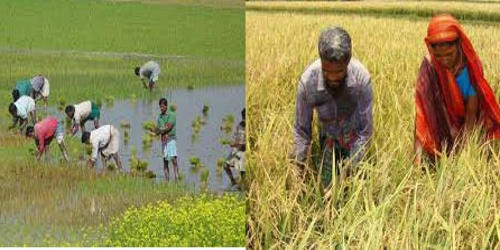- Co-Operative Farming
Co-operative farming refers to farming practices where farming operations are conducted cooperatively. Bangladesh is a predominantly agricultural country. She has plenty of fertile cultivable lands and a hard-working. Peasantry tied to the soil. With the growing population, she has been facing a chronic shortage of food. In respect of co-operative joint farming, individuals retain their ownership of respective plots of land and distribute the income of the farm among the members on the basis of the size and value of the plot along with their other contributions. For this, the blame lies squarely on her outmoded system of farming. She has a land of small scale farming; the small farmers cultivate a fragmented plot of land in primitive ways. It is not all a matter of pride rather of casting shame that her peasantry yet uses methods of cultivation that have long been lumbered. This is demonstrated by her low yield of crop per are. It compares most unfavorable with the technically advanced people of East and West.
Features of cooperative farming –
- In cooperative farming the below features are relevant;
- Farmers retain their right to land;
- Farmers pool their land, livestock and also other implements;
- The entire farm is managed as a single unit and management is elected by all the members; and
- Every member earns a share of the total production with their land contribution and labor performed.
In consideration of these Bangladesh Government has taken a comprehensive scheme of Co-Operative Farming. The scheme is set at the theatrical stage of discussion. But the outline of its based on the general principles to agricultural farming. Thus owners of contagious lands are to be asked to have their holdings joined in a scheme of helpful partnership. The small agricultural holdings will be merged in larger co-operative units.
At present, the owner of capital imposes terms that the peasant has to accept. But a co-operative farm, aided by the resources department of the agricultural Bank. In this manner, the resources would not only be more productive but also more economical in the long run.
The opposition to co-operative farming who are bound to tradition and cannot adjust their, minds to changing conditions of modern life, may jeopardize the success of the scheme. He can be induced to adopt new ideas any time, he sees the advantage thereof. Hence the scheme can be advanced only by educating the peasantry. Organized propaganda may gradually win the peasant to join in the scheme. Once he can be convinced with the enormous benefits of large scale farming, he will really be in favor of the scheme.
The state also has other duties than mere propaganda. It must be granted subsidies at the initial stage. In order to develop co-operative farming various facilities and incentives in the form of financial assistance, technical assistance, subsidies, additional facilities to supply high yielding seeds, fertilizers and other inputs were advanced by the Government. This can be done through the Reserve Bank as in the case of Co-Operative banking, it also must provide the necessary technical personnel as well as the agricultural expert.
















